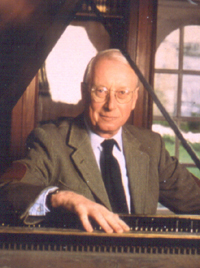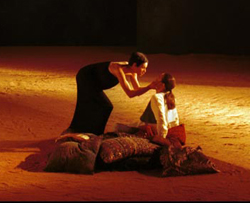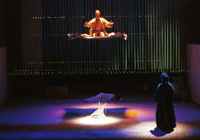The fountainhead of the French Baroque revival talks about another passion — Monteverdi, and the challenges of Il ritorno d'Ulisse in patria, which he performed at the 2000 Aix-en-Provence Festival and is currently touring.
 William Christie and his multiple-award-winning ensemble Les Arts Florissants
have developed a devoted audience all over the globe with their exciting
concerts and recordings (over 70 at last count) of 17th- and 18th-century music,
a repertory ranging from Gesualdo madrigals and Purcell odes to Handel oratorios
and Mozart operas. Some of his stage productions (most notably one of Lully's
Atys) have entered modern operatic legend. Yet most of all Christie is
revered throughout the classical music world as the man who, more than any other
individual, brought the music of the French Baroque back to life and made it
viable for the modern stage and concert hall. Quite something for a Buffalo boy
who went to Paris 30 years ago to study harpsichord.
William Christie and his multiple-award-winning ensemble Les Arts Florissants
have developed a devoted audience all over the globe with their exciting
concerts and recordings (over 70 at last count) of 17th- and 18th-century music,
a repertory ranging from Gesualdo madrigals and Purcell odes to Handel oratorios
and Mozart operas. Some of his stage productions (most notably one of Lully's
Atys) have entered modern operatic legend. Yet most of all Christie is
revered throughout the classical music world as the man who, more than any other
individual, brought the music of the French Baroque back to life and made it
viable for the modern stage and concert hall. Quite something for a Buffalo boy
who went to Paris 30 years ago to study harpsichord.
Christie and Les Arts Florissants are spending much of 2002 touring their acclaimed production of Claudio Monteverdi's opera
Il ritorno d'Ulisse in patria (The Return of Ulysses), which opens
at New York's Brooklyn Academy of Music on 7 April. andante's Matthew
Westphal spoke to him shortly before a performance of the opera in Caen about
the challenges of bringing this 360-year-old work to life.
Matthew Westphal: The biggest question about The Return of Ulysses
— the main question for anyone conducting a Monteverdi opera
— is the scoring. For Ulysses and Poppea we don't have
original scores, really, just a vocal line and a bass part
from which the continuo players [harpsichord, lute, harp, etc.] improvise chords to accompany that line. How do you go about
working that — just the voice part and the bass — into a performing
edition?
William Christie: Arriving at a consensus
with the musicians you're dealing with, first off. That's to say that you pick a
group of musicians who believe the same way that you do, because they're going to
have an awful lot of responsibility. Yes, you can flesh out a source like
the Vienna source [a 17th-century manuscript in which Ulysses
is preserved]; yes, there are things to be added to complete the material, but
there's an awful lot that's there already. My point of view is that you do not
have to sort of rewrite the score.
It's interesting that a month back, there were two productions of
Ulysses in Switzerland, one in Zurich and one in Lausanne, and they had
opened the same day — almost the same hour. One was a repeat of the
Harnoncourt version done in Zurich ...
MW: You mean the old one that was televised in the
1970s, the one directed by Jean-Pierre Ponnelle that used a whole huge kaleidoscope of Baroque instruments?
WC: ... yes, the old one from many years ago, and
the other one was mine. One of the critics pointed out the next morning that you
weren't sure it was the same composer, let alone the same piece. Now with all
respect due to someone like Harnoncourt, I think that just to say blithely, 300
and some-odd years after the fact, that we have to sort of help the score along
— that it can't really speak by itself, that it's an incomplete,
skeletal framework, one to which you have to add flesh and then clothes and then
makeup and then what-have-you ... I don't believe that, really. I believe
that obviously there was a strong element of improvisation; there could have
been other composers called to do some of the less "noble" tasks such as writing
dance music (although I don't really believe that's the case) and perhaps there
were other parts, more than we have in the source.
MW: More than just the continuo line, you mean?
WC: Actually there are a lot of upper parts in Ulysses. You have a splendid collection of
ritornelli [instrumental interludes], you have a
splendid collection of accompanied arias. My idea is that you should leave an
awful lot of this exactly the way it is. We're using a new score by
[musicologist and conductor] Alan Curtis, though I've taken things even from
Alan's version.
MW: What sort of things?
 WC: Well, the Melanto aria "Ama dunque," for
example, where he says that these little fragments of violin parts [in the
source] are obviously to indicate that this is a through-accompanied piece. I
don't believe that — I believe that the way the violins come in as
echoes is very satisfying musically. It makes extraordinary sense (in my
production at any rate) to play it just the way it's been put down on paper in
the Viennese source.
WC: Well, the Melanto aria "Ama dunque," for
example, where he says that these little fragments of violin parts [in the
source] are obviously to indicate that this is a through-accompanied piece. I
don't believe that — I believe that the way the violins come in as
echoes is very satisfying musically. It makes extraordinary sense (in my
production at any rate) to play it just the way it's been put down on paper in
the Viennese source.
I also believe that [music
with only] traditional continuo is not an arid moment where you're longing to hear
violins and sacbuts and flutes and shawms and whatever else that you can stick in.
Continuo, when it's played correctly as an improvising band, can be as exciting
as anything that you can orchestrate with other instruments. And then that makes
for these wonderful halos when the violins do come in to accompany — which suggests that the piece that
they're accompanying is very, very special in its dramatic and musical content.
This means, of course, that every member of this small
orchestra that's touring all around Europe and the States is a very important
part of the group. We have two lutes, two harpsichords, a lirone, a harp, three
bowed bass instruments, a dulcian [early bassoon] — and then we have a
solo first violin and second violin, violetta, two cornetti. This is rather large
for a Venetian theater of the 1640s — we could certainly have done
this piece with even less. But I don't believe in the overkill that we're
coming back to with a lot of Baroque people; Harnoncourt did his version 30 years
ago, and we have other colleagues who three years ago have been doing pretty much
the same thing. Even to the point of writing out the continuo.
MW: Your continuo players are all experienced in realizing bass
lines ...
WC: Absolutely — I've been playing with
them for 15 or 20 years.
MW: How about the melody instruments — the violinists and
cornettists? How much of their parts are they realizing (or have they realized)
themselves?
WC: They're playing extremely faithfully to the source. There's been no
added material except for the end of the second act, with the ballo,
which we've translated into a three-part canzona for voices. So essentially the
answer is nothing — except for noise, and sometimes colla parte
playing
[doubling vocal parts] to change color.
MW: How carefully do you plot out the realization of the continuo in terms of
instrumentation and the like?
WC: Every note.
MW: That is, "harp is playing here, lirone there, etc."
WC: Every note. It's just like a jazz band — pre-arranged, you
do this and I do that, whatever. It's a Duke Ellington orchestra of 1929 in the
sense that you've got a lot of common bass, but you've got Billy playing here,
Jimmy plays there, I don't play there ...
MW: Do you play much of the continuo yourself?
WC: Of course. If the piece is conducted, then the
piece is dead.
MW: What factors govern you when you're deciding which continuo instruments
to use where?
WC: It's the sense of the words and the dramatic sense. You begin with
something so basic as loud and soft, given that you have a continuo that can
play from pianissimo to fortissimo — that's the most basic sort of
thing. When you have the whole band playing, there's something really important
going on onstage and it's loud. Other than that, you have immense color effects
ranging from solo harp, to two harpsichords playing together without anything
else, to concerted effects where the bowed basses are actually forming chords to
accompany sinister passages. It begins very early on with the continuo people
working with the drama coach, with the language coach — which is a far
more important thing to do than just working musically — and it happens
much before we do any of the stage work.
And then after that there's a third consideration — it's spatial.
You have a pit, you have a harpsichord to either side, you have the continuo
instruments spread out the entire width of the stage. Why do I do that? Well,
there is iconographical evidence that suggests that it was like that, and it's
extremely good for the singers. And that means that there's a left and a right
and a middle, depending on the action on stage.
 MW: Do you find, compared to the French opera with which most people
associate you, that Monteverdi is less structured or structured in a different
way?
MW: Do you find, compared to the French opera with which most people
associate you, that Monteverdi is less structured or structured in a different
way?
WC: Oh, it's a different world — first of all it's a different
world linguistically. What they have as a common denominator is the fact that
they're language-obsessed. Why is Monteverdi writing the way he does? Well, it's
to set some fairly lovely libretti into recitative — just as Lully and
his contemporaries and successors are working with French classical theater. So
they're two moments in musical history where words are as important as music,
but other than that there are worlds of difference.
If you would like to respond to this
interview, please write to letters@andante.com.













 William Christie and his multiple-award-winning ensemble Les Arts Florissants
have developed a devoted audience all over the globe with their exciting
concerts and recordings (over 70 at last count) of 17th- and 18th-century music,
a repertory ranging from Gesualdo madrigals and Purcell odes to Handel oratorios
and Mozart operas. Some of his stage productions (most notably one of Lully's
Atys) have entered modern operatic legend. Yet most of all Christie is
revered throughout the classical music world as the man who, more than any other
individual, brought the music of the French Baroque back to life and made it
viable for the modern stage and concert hall. Quite something for a Buffalo boy
who went to Paris 30 years ago to study harpsichord.
William Christie and his multiple-award-winning ensemble Les Arts Florissants
have developed a devoted audience all over the globe with their exciting
concerts and recordings (over 70 at last count) of 17th- and 18th-century music,
a repertory ranging from Gesualdo madrigals and Purcell odes to Handel oratorios
and Mozart operas. Some of his stage productions (most notably one of Lully's
Atys) have entered modern operatic legend. Yet most of all Christie is
revered throughout the classical music world as the man who, more than any other
individual, brought the music of the French Baroque back to life and made it
viable for the modern stage and concert hall. Quite something for a Buffalo boy
who went to Paris 30 years ago to study harpsichord.  WC: Well, the Melanto aria "Ama dunque," for
example, where he says that these little fragments of violin parts [in the
source] are obviously to indicate that this is a through-accompanied piece. I
don't believe that — I believe that the way the violins come in as
echoes is very satisfying musically. It makes extraordinary sense (in my
production at any rate) to play it just the way it's been put down on paper in
the Viennese source.
WC: Well, the Melanto aria "Ama dunque," for
example, where he says that these little fragments of violin parts [in the
source] are obviously to indicate that this is a through-accompanied piece. I
don't believe that — I believe that the way the violins come in as
echoes is very satisfying musically. It makes extraordinary sense (in my
production at any rate) to play it just the way it's been put down on paper in
the Viennese source.  MW: Do you find, compared to the French opera with which most people
associate you, that Monteverdi is less structured or structured in a different
way?
MW: Do you find, compared to the French opera with which most people
associate you, that Monteverdi is less structured or structured in a different
way?